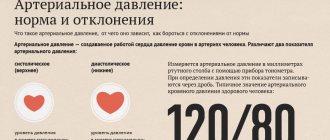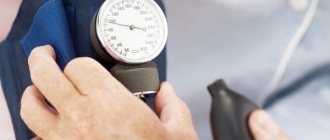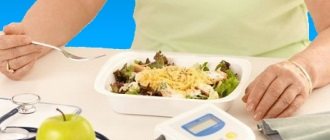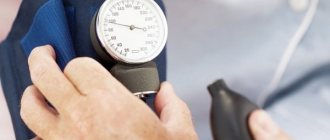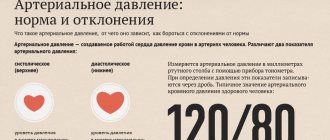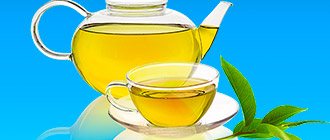(Health Center) There is a lot of talk about high blood pressure (hypertension). But low blood pressure (hypotension) seems to be considered a minor problem. The number of risks associated with hypotension is much less than with hypertension. However, those whose blood pressure is consistently below normal often feel tired and overwhelmed. For such people, knowing the possible causes of hypotension, and especially knowing how to stabilize low blood pressure, means a significant improvement in quality of life.
Causes of low blood pressure and ways to solve the problem
Low blood pressure causes lethargy and fatigue, accompanied by dizziness, decreased ability to concentrate and thus can significantly worsen your well-being. Doctors often tell hypotensive patients that low blood pressure is not as serious a problem as hypertension, and therefore nothing needs to be done.
But for anyone who would like to feel better, such words, of course, are of little use. Therefore, we will tell you about the possible causes of low blood pressure, which even doctors often do not think about, as well as how you can increase low blood pressure.
Low blood pressure - less than 100/60 mmHg
As you know, when measuring blood pressure, two indicators are distinguished: systolic and diastolic pressure.
First, the systolic blood pressure is indicated. This pressure occurs when the heart pumps blood into the arteries. It is always higher than diastolic pressure.
The second indicator is diastolic blood pressure. This is the pressure in the blood vessels between two contractions of the heart, that is, at the moment when the heart is not pumping blood.
Healthy blood pressure, according to today's understanding, is approximately 120/80 mmHg. Indicators above 140/90 mm Hg. Art. referred to as high blood pressure. If the pressure gauge regularly shows less than 90/60 mmHg. Art. and even less than 100/60 mmHg. Art., then they talk about low blood pressure. If only one of the two indicators is very low, this is already enough for the development of the corresponding symptoms.
What do the numbers on the tonometer mean?
Blood pressure characterizes the functioning of the body's cardiovascular system. To measure it, a device called a tonometer is used. The blood pressure value is recorded as two numbers:
- Upper. Displays blood pressure, which is recorded when blood is pushed out of the heart muscle. Its value is influenced by the force of contractions of the organ and the resistance that arises in the vessels.
- Lower. The numerical designation of diastolic blood pressure that occurs when the heart muscle relaxes. Reflects the resistance of the vascular walls.
Measuring indicators plays an important role in monitoring the state of the body, diagnosing a number of diseases, and understanding the processes of development and growth in children and adolescents.
50 mmHg Art.
We are talking about lower blood pressure. Such numbers on the tonometer are a deviation from the norm and can be dangerous. However, in order to determine why low blood pressure is bad for a person in this case, it is necessary to take into account the pulse difference indicator. What is dangerous:
- If the measurement showed a simultaneous drop in upper and lower blood pressure, then in many cases this condition is justified. As a rule, the result is typical for people who have arterial hypotension at birth. You should think about what low blood pressure means and why it is dangerous only when your health worsens.
- A pulse difference of more than 25% is dangerous. What is the threat of low blood pressure in a person with an impressive pulse difference? The indicator can signal the development of coronary heart disease, thyroid dysfunction, atherosclerosis, etc.
70 mmHg Art.
If the upper pressure is 70 mm Hg. Art., then most often we are talking about stable arterial hypotension. This condition is dangerous and requires contacting a doctor to identify the causes. As a rule, it is found:
- Arterial hypotension of 2nd severity. Blood pressure ranges from 100/70–90/60 mmHg. Art. Mostly there are no pronounced manifestations.
- Arterial hypotension of the 3rd degree. The blood pressure is 70/60 mm Hg. Art. or less. The condition requires special monitoring and pharmacological therapy.
80 mmHg Art.
The upper value is 80 mmHg. Art.—not critically low blood pressure in a person. However, this value is a deviation from the norm and may signal some pathologies.
Table 2. Why low blood pressure is dangerous
| Name | Details |
| Orthostatic hypotension | A drop in blood pressure occurs when the body position changes to vertical. Refers to secondary pathologies that develop due to the underlying disease. Affects overall well-being, reduces performance |
| Ischemic stroke | When considering the dangers of low blood pressure, it is necessary to separately note the danger of stroke. It is caused by poor cerebral blood supply |
| Deficiency of blood supply to organs | Low blood pressure affects not only the brain, but also vital organs, cells and tissues |
| Dementia | What else is dangerous about low blood pressure? It is a high risk of senile dementia. |
| IHD | Coronary artery disease develops for the same reason - due to insufficient blood supply to the heart muscle. |
| Decreased sensation in the arms or legs | Slightly lost |
| Hypertonic disease | Hypotension negatively affects the condition of blood vessels, which can lead to the development of the opposite condition - hypertension |
90 mmHg Art.
The next indicator, considering in the topic about what low pressure is considered dangerous, is an upper blood pressure of 90 mm Hg. Art. What is dangerous:
- It is an acceptable deviation from the generally accepted norm. This is a borderline value; lower heart pressure may indicate hypotension.
- If blood pressure leads to a worsening of the condition, then it is necessary to consult a doctor to obtain information about how dangerous the condition is for the patient.
The indicator can only be assessed on an individual basis. For some people, meaning is the norm, but for others it is dangerous.
- Low blood pressure during pregnancy - what to do. Causes and products for high blood pressure in pregnant women
90 to 50
The value may indicate the development of certain pathological conditions. To assess the situation, heart rate plays an important role. Why low blood pressure is dangerous:
- With a normal pulse (50–90). As a rule, the indicator is 90/50 mmHg. Art. in this case it is not dangerous.
- When elevated (more than 90). It can be triggered by intoxication, significant blood loss, pregnancy, and various diseases.
- Less than normal (up to 50). It is a sign of a heart attack, thromboembolism. Registered upon loss of consciousness.
90 to 60
Blood pressure with a normal heart rate is not dangerous. Often it is completely characteristic of a person. The meaning also provokes:
- regular sleep disturbances;
- unbalanced diet;
- bad habits;
- emotional and physical overload, etc.
If the condition is accompanied by abnormal pulse rates, this can be dangerous. In this case, you should not delay your visit to the doctor.
90 to 70
Seeing a deviation on the tonometer screen, a person involuntarily wonders what critical low pressure is dangerous for a person. The value should be assessed based on age:
- For young people. 90/70 is the norm for young people, especially often found in athletes or with an asthenic physique. Also, blood pressure drops with excessive exercise or violation of the regime. A score of 90/70 is not life-threatening.
- In adults. In the absence of unpleasant symptoms, it is not dangerous. If it affects the quality of life, then it is necessary to identify the cause of the condition.
- For the elderly. For people aged 60–65 years, low blood pressure can be critical. A value of 90/70 requires constant monitoring to assess how dangerous the condition is for the patient.
100 to 50
It can be either normal or a sign of hypotension. The following symptoms are cause for concern:
- faintness, loss of consciousness;
- decreased performance and concentration;
- deviation of the pulse rate up or down;
- peripheral sensory loss;
- the appearance of nausea, vomiting;
- pain in the heart area.
100 to 60
The indicator usually does not affect the person’s condition. The pulse difference is within normal limits. To assess the condition it is important:
- Compare pressure over time. If the patient has not previously had low blood pressure, then it is necessary to exclude hypotension.
- Assess the general condition. With dizziness, decreased activity, and general weakness, the condition requires attention. Could be dangerous.
- Consider additional factors. Conducted pharmacological therapy, time zone changes, irregularities, and diet can lead to low blood pressure.
100 to 70
To understand the individual blood pressure norm for a patient, his age, previous blood pressure readings, and lifestyle are taken into account.
Table 3. Why is blood pressure 100/70 dangerous in different age groups?
| Children under 3 years old | Increased |
| Children (3-12 years old) | Norm |
| Teens and young adults (12-21) | Typical for active young people with pronounced thinness. Most common in girls |
| Adults (up to 40) | The norm for hereditary predisposition and for athletes. If it does not cause discomfort, then it is not a cause for concern. |
| Elderly (60-65 or more) | Decreased. Requires regular monitoring, dangerous |
| Pregnant women | Decreased. Control required, dangerous |
100 to 80
A blood pressure of 100/80 is not dangerous for most people. The meaning causes concern for:
- Low heart pressure
- hypertensive patients;
- old people;
- pregnant women (especially dangerous in the first 3 months);
- if accompanying symptoms are detected (headache, nausea, fainting, low performance, etc.).
- if the pulse is abnormal (if it increases or decreases it is dangerous).
100 to 90
The indicator is characterized by a low pulse difference - less than 20 percent. Why is low blood pressure 100/90 mmHg dangerous? pillar:
- With normal heart rate. If the quality of life does not deteriorate, then special monitoring is necessary in the first trimester of pregnancy.
- With high heart rate. Signals about malignant or benign tumors, thyroid dysfunction, anemia, heart failure, etc.
A reading of 100/90 can be dangerous to health and life. Self-medication is not recommended.
110 by 90
In general, this indicator can be interpreted as normal, although the diastolic pressure is on the border of the maximum permissible state. Similar blood pressure can also be observed in hypertensive patients - it indicates the development of a hypotensive crisis and, as a rule, is accompanied by rapid heartbeat.
120 by 60
This blood pressure should not raise any questions. A large pulse difference with normal systolic blood pressure indicates vascular elasticity and good condition of the vascular system.
Blood pressure is constantly changing
However, blood pressure fluctuates and values can change greatly in a short time, even between two heartbeats. The fact is that blood pressure depends on many factors: body position (whether a person is lying, standing or running), breathing rate, stress level, state of health, nutrition, what medications a person takes, and the time of day . For example, at night your blood pressure is usually very low. When we wake up, it increases quickly.
Low blood pressure is often a good sign
It is possible that a person’s blood pressure is often low, that is, less than 100/60 mmHg. Art., but I feel excellent and have no complaints. This means that this blood pressure is optimal and helps a person stay healthy as they age.
Athletes tend to have lower overall blood pressure and a slower heart rate than the average person. Non-smokers, those who are of normal weight and who eat healthily also tend to have low blood pressure (which is a good sign), while smokers, people who are overweight, have a poor diet and are sedentary often have low blood pressure. have to deal with high blood pressure.
However, if your blood pressure is constantly low and you do not feel in good shape, then your blood pressure is definitely TOO low and you need to start looking for the causes and solutions to the problem. You may be experiencing the symptoms listed below.
Content:
- What is hypotension?
- Low blood pressure - causes
- Low blood pressure - symptoms?
Arterial pressure
– the main indicator of hemodynamics, which determines the speed and volume of blood flow in all tissues. The condition refers to polyetiological pathological processes. This means that it develops due to the influence of several causes. Clinical symptoms include manifestations of hemodynamic disturbances with oxygen starvation of tissues.
Symptoms of low blood pressure
Low blood pressure is manifested by the following symptoms:
- dizziness to the point of fainting,
- darkness before the eyes when standing up,
- visual impairment,
- noise in ears,
- headache,
- fatigue and decreased concentration,
- dyspnea,
- pallor,
- cold feet and hands.
A sudden drop in blood pressure can be dangerous. Even its decrease by only 20 mm Hg. Art. (eg, from 110 to 90 mm Hg in systole) sometimes causes dizziness and loss of consciousness because the brain does not receive enough blood as a result.
If blood pressure decreases as a result of significant blood loss (in an accident), serious infections or allergic reactions, low blood pressure can be life-threatening. Fortunately, this rarely happens.
For what reasons does blood pressure most often drop?
There are two main types of arterial hypotension – physiological and pathological. In the first case, the patient feels absolutely normal, he does not express any complaints, since the indicators are quite normal for him. In such a situation, assistance is not required. If low blood pressure is a sign of a specific disease, the clinical picture includes additional symptoms that significantly impair a person’s quality of life, suggesting a concomitant disease.
Primary, or essential hypotension develops for reasons that are inexplicable to modern medicine. Doctors suggest the influence of a sum of factors: individual genetic characteristics, reduced (sometimes increased) physical activity, excessive emotional and mental stress, poor nutrition.
When the cause of hypotension is a specific disease, we are talking about secondary (symptomatic) hypertension, which develops as a result of:
- vegetative-vascular dystonia;
- spinal cord injuries and diseases;
- endocrine disorders (hyperthyroidism, hypoglycemia, Addison's disease);
- taking certain medications or poisoning with them (most often occurs with an overdose of drugs to treat a hypertensive crisis);
- dehydration due to fever, prolonged vomiting or diarrhea, increased sweating (hyperhidrosis);
- infectious diseases;
- allergic reactions;
- acute or chronic blood loss;
- fasting (postprandial hypotension).
A special type of this condition is considered to be orthostatic hypotension, in which symptoms of low blood pressure appear with a sudden change in body position, for example when standing up. The condition is more common in older people.
Types of low blood pressure
In general, low blood pressure conditions fall into three categories:
- Primary hypotension
In this case, the causes of hypotension are unknown. It is believed that slender young women often face this problem. This form of low blood pressure also occurs in people who lead a sedentary lifestyle. However, in general, this group includes all hypotensive patients whose causes of low blood pressure remain unclear from the standpoint of official medicine.
- Secondary hypotension
The adjective “secondary” means that hypotension is a consequence of another disease or the result of other known factors. This could be a hormonal imbalance (Addison's disease, low thyroid function), a side effect of medications taken, heart disease, or a phenomenon accompanying an infectious disease.
The advantage of secondary hypotension is that when the cause of low blood pressure is known, it is easier to find a solution.
- Orthostatic hypotension
This form of low blood pressure manifests itself primarily in the fact that when getting up from a lying or sitting position, you feel dizzy, your vision becomes dark, and you feel like you need to grab onto something to avoid falling.
When a person stands up, the blood naturally goes down to the legs. A healthy body easily compensates for this displacement: the blood vessels narrow, the heart begins to beat faster. Thanks to this, the brain is supplied with blood.
In people suffering from orthostatic hypotension, this regulatory mechanism is disrupted. Blood pressure drops, and in the worst case, the person loses consciousness.
This form of low blood pressure can be caused by various reasons. Blood pressure does not necessarily remain low all the time - it may only happen on some days or only during certain periods, for example during pregnancy, during extreme heat or after lying in bed for a long time. Diabetes, heart problems, certain neurological disorders, and varicose veins also—along with the medications listed below—may increase the risk of orthostatic hypotension.
Those diagnosed with orthostatic hypotension should rise very slowly. You should not get up immediately from a lying position: you must first sit down, sit for one or two minutes and only then get up.
Sometimes blood pressure drops immediately after eating. This form of hypotension is called postprandial hypotension.
Symptoms of low blood pressure
In addition to feeling unwell, hypotension brings with it more significant problems:
- Reduced pressure leads to insufficient blood supply to all organs and oxygen starvation of the brain, which is more sensitive to lack of oxygen.
- The result is weakness, lethargy and fatigue.
- Signs of low blood pressure also include dizziness, often motion sickness in transport, daytime drowsiness and disrupted night sleep, which only intensifies fatigue and weakness.
- One of the most unpleasant symptoms of hypotension is orthostatic hypotension. When standing up suddenly and changing body position, dizziness becomes stronger.
There are primary and secondary hypotension.
| Primary arterial hypotension | This is an independent disease in which hereditary predisposition and constitutional characteristics play an important role (usually young women of asthenic physique - slender, tall, emotional). |
| Secondary hypotension | It develops against the background of other diseases, such as hepatitis, peptic ulcers, anemia, allergic reactions, in case of poisoning, as a result of the side effects of certain drugs. In this case, hypotension is not considered as a disease, but as a symptom that goes away after the cause is eliminated. |
Postprandial hypotension
In people with postprandial hypotension, too much blood flows into the digestive system after eating. Compensation mechanisms, which in a normal situation ensure blood supply to the brain as before, despite the digestion of food, do not work in this case.
Postprandial hypotension is often observed in hypertensive patients, which, of course, can be explained by incorrect dosage of drugs to lower blood pressure.
If you have postprandial hypotension, you should always eat only small portions and ensure that the food is healthy, nutrient-dense and does not contain isolated carbohydrates (sugar, white flour products).
How do foods affect blood pressure?
Blood pressure is affected by both the composition of a person's diet and their eating habits, including how often they eat, how large their portions are, and how much fluid they drink. A healthy, balanced diet is one of the conditions for maintaining a healthy cardiovascular system, normal heart function and optimal blood counts. All this is directly related to blood pressure values.
What foods increase blood pressure?
There are a number of food products that increase the tone of the walls of blood vessels, the volume of fluid (and blood pumped), and also compensate for the deficiency of vitamins associated with hypotension.
Blood pressure increases when you eat the following foods:
- Salt, additives, seasonings containing sodium: retain fluid, increasing its volume in the body, increasing the volume of blood pumped. Salt intake should not be too high even with hypotension. WHO recommends consuming no more than 5 g of salt daily (1 teaspoon).
- Products containing caffeine: coffee, green tea, cocoa, strong sweet tea tone up and increase heart rate.
- High-calorie dishes. Baked goods, meat products, cheese, sweets, and high-fat dairy products provoke an increase in blood sugar, which causes blood pressure to rise. It is important for people with hypotension to eat foods that are nutritious enough, but they need to be careful that they are not excessively high in calories or contain too many carbohydrates or saturated fats.
- Products containing vitamins C, B12, E. With a deficiency of these vitamins, anemia develops, which is associated with the appearance of hypotension. By normalizing their consumption, you can reduce its manifestations. Citrus fruits, parsley, and red bell peppers contain a lot of vitamin C. Vitamin B12 is found in eggs, meat, and dairy products. Vegetable oil, avocados, and nuts contain a lot of vitamin E.
Important! Some foods prohibited for hypertensive patients can increase blood pressure: fatty, fried, too spicy foods, but using them to cope with hypotension is not recommended. Such food increases cholesterol levels in the blood, has a bad effect on the digestive system, and can cause additional health problems.
Foods that sharply increase blood pressure
Hypotension can make a person feel unwell, and it is important to know what to eat to raise blood pressure quickly. The following will help you feel better:
- black coffee;
- strong black tea;
- bitter chocolate;
- salty foods (this could be salted cheese, pickled vegetables, salted fish);
- prunes, dried apricots or other dried fruits;
- pomegranate juice;
- honey.
These products should only be used if it is known for sure that poor health is caused by hypotension. You can verify this by measuring your blood pressure. If symptoms associated with hypotension appear frequently, you should consult a doctor (general practitioner or cardiologist) and follow his recommendations.
Coffee and chocolate contribute to a rapid increase in blood pressure. Photo: nanka-photo / Depositphotos
What foods increase blood pressure during pregnancy?
In the first half of pregnancy, against the background of hormonal changes, blood pressure may decrease due to a decrease in the tone of the walls of blood vessels. This is normal, but if you experience symptoms associated with hypotension, you should inform your doctor. Blood pressure levels should return to normal after childbirth. If it becomes low during pregnancy, you need to make sure that this is not caused by anemia (for this, a blood test is taken).
To increase blood pressure during pregnancy, only certain foods can be used: chocolate, tea, pomegranate juice. Even they are not advisable to consume in large quantities so that the pressure does not become too high. This can be dangerous. It is also undesirable to increase the consumption of water or coffee (this may create additional stress on the kidneys), spicy, fatty, salty or too high-calorie foods. It is better to consult with your doctor and get nutritional recommendations from him, taking into account your general health, the duration of your pregnancy, and the characteristics of its course.
During pregnancy, you should be more careful when choosing your diet. Photo: Amina Filkins: Pexels
What foods should you not eat if you have high blood pressure?
Some foods can not only normalize blood pressure, but also increase it excessively. Eating these foods may be dangerous if a person already has hypertension. In this case, follow a special diet, excluding or limiting the consumption of the following foods:
- salt, seasonings, food additives containing sodium;
- strong tea, coffee containing caffeine;
- fatty, fried, spicy foods;
- pickles and canned foods;
- smoked meats;
- baked goods, sweets;
- fast food;
- sweet carbonated drinks;
- ready-made sauces, seasonings, flavor enhancers, and other additives that may contain sodium;
- frozen semi-finished products: pizza, dumplings and other similar dishes (may contain a lot of sugar, sodium, saturated fat to preserve taste);
- alcohol.
To prevent excessive stress on the heart and the appearance of essential hypertension, you need to adhere to a healthy, balanced diet in the same way as when preventing hypotension. Both hypertensive and hypotensive patients are equally benefited from fresh vegetables, nuts, herbs, fruits, whole grains, lean meat, poultry and fish. If your blood pressure is high, you need to eat more foods containing potassium, magnesium, and calcium. Bananas, beans, spinach, and sunflower seeds are especially useful.
Causes of low blood pressure
Often it is not possible to find out the cause of low blood pressure. This may be unpleasant for patients, but does not have serious consequences - unlike patients with chronically high blood pressure.
However, often the doctor is the cause of low blood pressure, which is not thought about at all. Of course, not directly, but indirectly. Many people have had their blood pressure rise during a doctor's appointment at some time in the past. They were prescribed drugs to lower blood pressure, patients diligently took the pills, and it did not occur to them to check whether this was still necessary.
- Blood pressure lowering medications are the main cause of high blood pressure
In the summer of 2021, the results of a study on this topic were published. It covered more than 11,000 patients over the age of 70 years. 1,900 of them had low blood pressure. Imagine: 1,246 of them were taking blood pressure medications. Of those with the lowest blood pressure, 70 percent used such drugs.
Thus, in older people, the main cause of too low blood pressure is blood pressure-lowering medications.
Apparently, they are prescribed very often, without thinking about the fact that the patient's condition may change. Some people are prescribed other drugs over time (see point 2).
The interaction of medications is not always taken into account, and therefore a situation may arise when medications further reduce blood pressure, lowering it below a minimum. At the same time, it is precisely in older people that too low blood pressure often causes death and referral to the hospital - this fact was noted by the authors of the study.
Therefore, if, while taking medications to lower blood pressure, you feel unwell, often feel dizzy and weak, it is possible that the cause of this condition is not high blood pressure, but, on the contrary, too low blood pressure due to the medications. Consult your doctor about this!
The most well-known drugs that lower blood pressure include:
- diuretics (diuretics), such as furosemide and hydrochlorothiazide, which are prescribed for high blood pressure, but also for edema, heart and kidney failure and hyperkalemia (excess potassium),
- alpha blockers, such as prazosin,
- beta blockers such as atenolol.
- Medicines
In addition to special drugs, other drugs can reduce blood pressure and thus cause hypotension. Many of them were developed and are assigned to solve completely different problems.
- Medicines for Parkinson's disease, such as pramipexole, and products containing levodopa.
- Some (tricyclic) antidepressants, for example, doxepin, imipramine, etc.
- Viagra (sildenafil), especially in cases where nitroglycerin is also taken for heart support (against angina).
- Sedatives.
- Antihistamines.
- Pregnancy
During pregnancy, due to increased stress on the body, blood pressure can drop significantly. As a rule, blood pressure returns to normal, at the latest after childbirth.
- Heart problems
If the cause of too low pressure is heart problems, the matter is not limited to slight dizziness. Many other complaints also arise. Heart problems that can cause low blood pressure include bradycardia (very low heart rate), heart valve disease, myocardial infarction, or heart failure.
- Functional disorders of the thyroid gland
Reduced thyroid function can also cause low blood pressure. Because both conditions (low glandular function and hypotension) have similar symptoms, patients sometimes think they “only” have low blood pressure. But in fact, there may be a malfunction of the thyroid gland.
- Adrenal insufficiency
If adrenal function is weakened, low blood pressure may occur along with other symptoms. The adrenal glands, which sit directly on the kidneys, produce hormones including adrenaline and norepinephrine. Both of these hormones activate the body. When needed, they speed up the heart rate, improve blood flow to the muscles, promote the release of glucose and increase blood pressure.
In the case of chronic adrenal insufficiency, such an activating effect on blood pressure is absent, blood pressure becomes chronically low, and the person feels completely powerless.
- Dehydration
Dehydration (lack of water) is also a serious cause of low blood pressure. It occurs in those who consume too little fluid or lose a lot of fluid due to certain circumstances (such as diabetes, fever, vomiting, diuretic abuse, extreme sports without drinking). Even slight dehydration can cause weakness, dizziness and fatigue.
- Deficiency of essential substances
Lack of vitamin B12, folate (folic acid) or iron leads to anemia. The body loses its ability to produce enough red blood cells. As a result, anemia develops and blood pressure decreases. There is a feeling of weakness, loss of strength. Other B vitamins and vitamin C also improve blood pressure and can seriously help with low blood pressure.
Causes of low blood pressure
In old age, with vessels affected by atherosclerosis, low pressure can occur due to decreased tone of the smooth muscles of blood vessels and the heart muscle. During vagaries of weather and monthly hormonal fluctuations, the decrease in pressure can be significant.
Hypotension can be a consequence of nervous overstrain; it often develops as a consequence of infectious and other diseases, after viral and colds, flu, in the legs, as well as with insufficient or disordered nutrition, restrictive diets.
Low blood pressure: natural ways to improve your health
Even the list of possible causes already given shows that there are many ways to increase low blood pressure again. First you need to find out the cause of low blood pressure. When it is found, treatment begins.
This is not always easy: problems begin already in cases where low thyroid function or adrenal insufficiency is diagnosed. Often official data says that everything is fine, but a person feels completely different.
Adrenal insufficiency is detected by examining saliva. Specific measures should be discussed with a specialist in alternative medicine.
As much air as possible
Clear, cool or frosty weather with high atmospheric pressure is the best time for hypotension. The air is maximally saturated with oxygen, so you need to walk for several hours in a row every day. Even better is to play sports outside, such as cross-country running or skiing.
In cloudy weather, it is also not recommended to sit within four walls. Stuffy indoor air is the worst environment for low pressure. It is advisable to ventilate your home and workplace as often as possible.
Contrast shower and Kneipp douches
Master the contrast shower and practice Kneipp douches. Yes, you can prescribe what is called hydrotherapy if your doctor agrees that it will help combat low blood pressure.
When dousing, the following must be taken into account. Warm water relaxes and relieves spasms, while cold water mobilizes. If you have low blood pressure, you should either use cold water or change the temperature of the water: this activates blood circulation and helps increase blood pressure.
Kneipp foot soaking is commonly practiced. To do this, cold water (temperature 20 degrees) is poured onto the foot from the knee, then directly onto the foot and again up the calf to the popliteal fossa, and then down again. After a warm shower, you can quickly douse yourself with cold water. If this is difficult for you, limit yourself to cold pouring on your feet.
Signs and consequences of low blood pressure
According to specialists from Carnelian MC, the manifestation of low blood pressure is typical for young women under the age group of 40 years.
Symptoms of disturbances include:
- insufficient blood circulation, leading to throbbing pain in the temporal region of the head;
- sudden change of mood;
- constant apathy, lethargy, feeling tired. The body is not able to recover after a good rest and sleep.
Low blood pressure can manifest itself for various reasons: as a result of previous infections, underweight, anemia, unfavorable work factors, changes in climatic conditions or seasonality. Also, pressure can change as a result of a lack of vitamins, indicating anemia, pre-infarction condition, weight deficiency, cardiosclerosis, VSD, renal failure, low hemoglobin, circulatory disorders, etc.
With a slight change in blood pressure, people live full lives. To avoid health problems, experts recommend exercise, adhere to a healthy lifestyle and proper nutrition, often walk in the fresh air, give up alcohol and take vitamins and fruits. A person should also avoid stress and take care of his health, constantly monitor his blood pressure and keep it normal. Measurements should be taken several times a week; you should not drink alcoholic drinks or coffee, play sports, smoke, or swim in hot water beforehand.
Drink still water regularly
With low blood pressure, water helps not only from the outside, but also from the inside. If you are one of those people who often forgets to drink enough, the first thing you should do at the first symptoms of low blood pressure is drink a large glass of water. Often this is already enough.
As stated above, not drinking enough fluids can seriously aggravate, if not cause, low blood pressure. Therefore, regularly drink 30 ml per kilogram of weight per day. To do this, it is best to choose high-quality still or lightly carbonated water.
To enhance the effect of a glass of water for severe dizziness, cook vegetable broth and drink it or simply add a little salt to the water.
Fighting sleepiness
To avoid falling asleep on the go all day, it is recommended to drink coffee: in moderation, 2-3 cups. Hypotonic patients can indulge in this drink in the evenings without harm to their health. It does not cause insomnia, on the contrary: it returns a comfortable physical state and makes it easier to fall asleep. The next morning after drinking coffee, such people also feel more energetic.
But you need to be careful with green tea. Although it contains caffeine, other active substances in the drink dilate blood vessels, lowering blood pressure even more. For hypotension, strong black is more beneficial.
If you are very tired during the day, it is recommended to take a short rest: sleep for about 1–1.5 hours. This will allow the nervous system to reboot and give strength for the second half of the day. If this is not possible, it is advisable to have on hand collections of invigorating plants: lemongrass, eleutherococcus, ginseng root. In extreme cases, a can of energy tonic will do. But you can drink it no more than twice a month. Otherwise, the opposite effect will occur - vascular tone will decrease.
Check the level of vital elements in the body
Get tested for essential minerals and vital substances (vitamin B12, vitamin D, iron, zinc, etc.) and check whether your diet contains enough of the necessary elements. To do this, you can contact a healthy nutrition consultant. If in doubt or found to be deficient in specific substances, take appropriate nutritional supplements.
You can almost always take magnesium and a high-quality B vitamin complex, even without testing. Magnesium is a mineral that is involved in many reactions in the body and at the same time is present in insufficient quantities in modern food. Therefore, in most cases, taking it is only beneficial.
The same can be said about B vitamins. In addition, these vitamins dissolve in water, and therefore, in case of excess intake into the body, they are simply excreted in the urine. Along with vitamin B12, vitamin B5 is also especially important for low blood pressure: its deficiency can provoke hypotension.
Vitamin C deficiency is also a cause of low blood pressure. This is because vitamin C stimulates blood circulation, and therefore blood pressure.
General recommendations for nutrition for hypotensive patients
With hypotension, it is important to adjust both the diet and diet. There are several eating habits that contribute to high blood pressure:
- Eat more often, but in small portions. This will ensure a constant supply of energy and high tone.
- Drink more water. When dehydrated, the volume of circulating blood decreases and blood pressure drops. If a person drinks enough water, the blood volume will be larger and the blood pressure will be higher. You need to additionally increase the volume of fluid you drink in hot weather and during physical activity.
- Don't skip meals. Such omissions can provoke overeating, which will cause blood pressure to drop.
- Reduce alcohol consumption. It causes dehydration and may worsen hypotension.
To improve your health with hypotension, you need to change your diet as follows:
- Get enough salt from food. Hypotonic people can eat dishes with added sea or table salt, as well as canned vegetables, cheeses, and salted fish. This will help retain fluid in the body and increase blood volume to increase blood pressure. In this case, total salt consumption should not exceed 5 g per day.
- Drink caffeinated drinks. It is better if it is natural coffee, black or green tea. The caffeine they contain causes heart rate to increase and blood pressure to rise. This effect is temporary. It should not be overused: if a person drinks a lot of coffee or tea, it can have a bad effect on heart health. In addition, over time, tolerance to caffeine may develop, and it will no longer provide a tonic effect.
- Get more vitamin B9 and B12 from foods. Hypotension may be associated with anemia caused by a deficiency of B vitamins. Hypotonic people need to eat more foods containing vitamin B12 (fish, chicken, eggs, low-fat dairy products) and B9 (broccoli, asparagus, lentils and chickpeas, liver).
- Control your carbohydrate intake. If your diet contains a lot of foods containing carbohydrates, this can have a bad effect on your heart condition and cause anemia. In addition, such foods are quickly digested, after which the pressure drops sharply. To reduce the symptoms of anemia, you need a balanced diet. It should not be overloaded with foods containing easily digestible carbohydrates (sweets, starchy foods, sweet vegetables, fruits and dried fruits, foods and drinks with added sugar).
In addition to nutrition, healthy habits such as good sleep and exercise are important (Figure 2).
Figure 2. General recommendations for hypotensive patients. Source: MedPortal
List of foods you can eat for hypotension
Hypotonic people can eat almost any food, but it is important that the diet remains balanced. The menu can include:
- fresh vegetables and salads made from them with added salt (but it is better to limit the overall use of salt and control it so that it does not provoke swelling);
- boiled or baked vegetables;
- cereals;
- fruits, dried fruits in limited quantities;
- meat, poultry, fish (preferably low-fat so that the level of cholesterol in the blood does not increase);
- cheeses, dairy, fermented milk products;
- bread, pastries, sweets (in limited quantities);
- chocolate;
- coffee and other caffeinated drinks;
- eggs;
- spices, hot seasonings (including ginger, pepper).
Additional dietary restrictions may apply that are not related to high or low blood pressure. To take them all into account, it is better to create a menu together with your therapist or nutritionist.
Check your vitamin D levels
Vitamin D levels are particularly important: today in Central Europe there is usually not enough vitamin D, which is responsible for many chronic diseases. Vitamin D is the sun vitamin, that is, the vitamin that is formed in the skin when exposed to ultraviolet radiation. Food contains very little of it. Thus, a lack of sunlight usually means a deficiency of vitamin D.
Among other things, it is involved in regulating blood pressure. Therefore, a lack of this vitamin can contribute to low blood pressure. A study published in 2014 found that vitamin D deficiency increases orthostatic hypotension, especially in older people.
During pregnancy
Low blood pressure during this period should be considered as part of the development of pathology. And in order to present a more complete picture of the causes and possible consequences of this phenomenon, the process must be divided as follows:
- The first possible cause of low blood pressure is pregnancy itself. That is, it provokes this phenomenon due to early toxicosis that occurs in the first half of the term.
- The second option is that the cause of hypotension is associated with complications associated with pregnancy - this could be a threatened or already begun abortion, accompanied by uterine bleeding. In other cases, blood pressure usually increases.
- Hypotension - already occurred before pregnancy and did not disappear when it occurred. Under such circumstances, there is no threat to the future woman in labor. But serious complications can occur for the fetus. Since slow blood flow in the vessels also negatively affects the blood circulation of the fetus. Intrauterine hypoxia may occur, and this is fraught with very serious consequences.
Rule out cryptopyrroluria
If you have symptoms other than low blood pressure, such as depression, hair loss, cracked lips, skin problems, or hormonal imbalances, consider getting tested for cryptopyrroluria.
This metabolic disorder also causes low blood pressure.
If the cause of low blood pressure cannot be found or if the condition does not improve despite all efforts to improve your lifestyle, it is usually recommended to simply move more or drink small amounts of alcohol or strong coffee. These measures, with the exception of physical activity, cannot be called healthy. Caffeine and alcohol have only a short-term effect, which means they cannot solve the problem for a long time.
However, there are methods and solutions that allow you to increase blood pressure not only reliably, but also without harm to health.
Diagnostics
During the initial examination, a general practitioner or cardiologist assesses the constitution and nutritional status, and conducts a physical examination of the respiratory and cardiovascular systems. In addition to standard blood pressure measurements, 24-hour blood pressure monitoring is recommended to obtain a complete picture. A diagnostic search involves the appointment of a set of laboratory and instrumental methods:
- Blood tests.
The hemogram often has a reduced content of hemoglobin and red blood cells, and with infectious shock, high leukocytosis is observed. During a biochemical blood test, attention is paid to the level of total protein, electrolytes, and cholesterol. For symptoms of anemia, serum iron, ferritin, and transferrin levels are examined. - Hormonal studies.
If persistently low blood pressure is detected, the level of thyroid hormones T3 and T4 and the pituitary hormone TSH must be measured. The concentration of catecholamines and adrenal steroid hormones is determined in the blood and urine. According to the indications, the level of insulin and C-peptide is assessed. - ECG.
Used as a screening method to assess the electrical activity of the heart. If cardiac arrhythmias and signs of myocardial ischemia are detected on the cardiogram, echocardiography is necessary. With echocardiography, the contractility of the heart is assessed and structural anomalies are found. - Neurological examination.
In the absence of other causes of low blood pressure, the patient is referred to a neurologist. To assess the functioning of the autonomic nervous system, the doctor performs breath-holding tests during inhalation and exhalation, orthostatic and clinostatic tests.
Rosemary - a remedy for low blood pressure
Rosemary essential oil is believed to effectively stimulate blood circulation, increase blood pressure and refresh the body, so much so that patients with high blood pressure should not take it.
However, those with low blood pressure can use rosemary oil in a variety of ways.
Buy a bottle of rosemary essential oil. If necessary, open it, bring it to your nose and inhale deeply. You can add a few drops to an aroma lamp.
In addition, rosemary essential oil is added to shower gel (1 drop per serving) or to the bath (so many drops for the scent of rosemary to be intense).
Camphor (Spanish) rosemary is best suited - it contains more camphor, which is the active ingredient in rosemary oil that affects blood pressure.
You can drink rosemary tea in the morning if you like it.
Treatment of hypotension
If a patient experiences the above symptoms, try (if possible and if you have the appropriate skills) to measure the person’s blood pressure using a tonometer. If the results are below normal, it is necessary to immediately provide the victim with first aid. When, despite your efforts, the condition does not improve, it is recommended to call the emergency team.
First aid
First aid for hypotension is provided according to the following algorithm:
- Place the person on a hard, level surface. Raise your lower limbs and lower your head slightly to ensure blood flow to the central organs - the brain and heart. This position is called anti-shock.
- Provide fresh air. To do this, open a window if you are indoors and clear your airways by loosening tight clothing.
- If the patient has medications for hypotension, help him take them.
- Give the victim some hot sweet tea or coffee. You can also offer to eat something salty.
If the patient has lost consciousness, follow these steps:
- Provide anti-shock position.
- Do not hit the victim on the cheeks. Sprinkle it with cold water or give it a sniff of ammonia. Just don’t put a bottle of caustic liquid under his nose. Accidentally touching and overturning a bottle can cause serious chemical burns to the nasal mucosa. Just drop a little of the substance on a napkin or handkerchief and bring it to your nostrils - this will be quite enough.
- If the person does not regain consciousness within 1-2 minutes, call an ambulance.
When you experience an attack of hypotension for the first time, you should immediately contact your doctor at the clinic for a preventive examination.
Emergency actions
The paramedic of the emergency team at the prehospital stage should act according to the following protocol:
- Place the patient in an anti-shock position if this has not been done previously.
- Determine the presence of breathing disorders and, if necessary, begin oxygen therapy with artificial ventilation.
- Provide peripheral venous access (catheterization).
- Start infusion of NaCl solution 0.9% at a rate of 40 ml/kg/h. If necessary, administer colloids (20 ml/kg/hour).
- Every 15 min. monitor pressure, saturation, pulse in the carotid artery.
- If infusion therapy is not effective, administer intravenous vasopressors (“Norepinephrine” 2-8 mcg/min. or “Dopamine” 10-15 mcg/min.), having previously dissolved them in 400 ml of 0.9% NaCl solution.
- Stop decompensating bradycardia or other arrhythmias.
- If hypothermia develops, carry out warming measures.
- In the absence of positive dynamics, hospitalize the patient.
In a hospital setting, it is necessary to catheterize a second peripheral or central vein while continuing infusion therapy with colloids or crystalloids. Do not stop administering vasopressors, the doses of which can be increased if necessary. When SaO2 (saturation) is low, oxygen supply must be provided. If there are no positive changes, extensive diagnostic measures should be carried out to search for other possible causes of hypotension and prescribe specific treatment.
Licorice - a remedy for low blood pressure
Licorice is often used for coughs, as it has an antiviral effect, and for inflammation of the gastric mucosa, since this plant successfully fights even Helicobacter pylori.
Licorice contains so-called glycyrrhizic acid (also called glycyrrhizin), which, in addition to these effects, is known to increase blood pressure.
In 2015, the results of a study on one 65-year-old patient were published. She had high blood pressure, but it was stabilized with medication. Suddenly she needed emergency help: her blood pressure rose to 200/140 mmHg. Art.
Intravenous administration of blood pressure-lowering drugs did not produce results. The woman spent seven days in the hospital, five of them in the intensive care unit. Finally, the blood pressure was lowered with the help of three appropriate medications. It later turned out that this patient loved licorice candies, and ate two to four packages a day. Licorice is made from licorice root extract.
A similar study published the same year involved a 45-year-old woman who told her doctor that she had been experiencing hot flashes, sweating, and headaches for 4 months. It turned out that she had high blood pressure and her calcium levels were low. It was later learned that this patient drank six cups of licorice tea daily to wean herself off coffee. Two weeks after she stopped drinking this tea, the symptoms disappeared.
Thus, it is clear that licorice root can increase blood pressure. If your blood pressure is already high, it is better not to drink licorice tea. When blood pressure is too low, this tea in moderation can be very beneficial.
Glycyrrhizic acid from licorice root blocks certain enzymes, resulting in the activation of the stress hormone cortisol, which then increases blood pressure.
Today, experts do not recommend consuming more than 100 mg of glycyrrhizin per day - precisely because this substance affects blood pressure, and for most people it is already very high.
50 mg of licorice (some varieties) contains 100 mg of glycyrrhizin. If licorice contains more than 200 mg of glycyrrhizin per 100 g, in Germany it can only be sold in pharmacies and not as a sweet in supermarkets.
Many modern sweets containing licorice contain artificial flavors anyway and only a little real licorice, which means little glycyrrhizin. Therefore, licorice is a very unreliable source of glycyrrhizin if it is necessary to increase blood pressure. Exceptions are possible only if data on glycyrrhizin content are obtained from the manufacturer.
Dried licorice root, which is sold cut into slices in tea shops, contains 200 to 600 mg of glycyrrhizin per 5-15 g. Thus, you can brew a tea from 5-10 g of licorice root daily and drink it throughout the day.
It is officially not recommended to consume licorice products for more than four to six weeks, but this advice applies to all medicinal teas. Periodic breaks avoid addiction and prevent possible side effects.
The glycyrrhizin found in licorice, when taken over a long period of time, can actually cause symptoms in susceptible individuals that indicate elevated cortisol levels. These are, for example, accumulations of fluid, which are manifested by swelling in the face and joints of the feet, increased blood sugar levels, disturbances in the functioning of the heart and, of course, increased blood pressure, although for hypotensive patients this effect is desirable.
But two cups of licorice root tea a day won't cause any problems and will still help raise your blood pressure.
Diagnosis and treatment
Considering the fact that hypotension can serve as a symptom of many diseases or be an independent pathology, an examination is necessary to exclude diseases that could lead to a decrease in pressure. In this regard, there is no strictly defined list of examinations. To understand why the patient has low blood pressure, a diagnostic plan is drawn up and prescribed strictly individually, taking into account the patient’s history and previous diseases.
When establishing the cause of the disease, therapy usually uses complex methods aimed at restoring and strengthening the vascular wall and treating the underlying disease, if required, strengthening the autonomic nervous system and immune processes. General stimulants are prescribed, for example, drugs containing caffeine.
Many herbal preparations, so-called “folk remedies,” also have a tonic effect, which can also help with low blood pressure (hypotension). Self-administration of such drugs, however, requires great caution, because the same substances can have different effects on different people. Sometimes a paradoxical reaction and deterioration of the patient's condition may occur.
You should not self-medicate for hypotension! Only a doctor can prescribe the drugs necessary for a particular patient after he has examined the patient and established the cause of hypotension and the characteristics of its course.
Tulsi - a remedy for low blood pressure
In 2013, the results of a study were published on the effects of the so-called holy basil (tulsi) on low blood pressure in women aged 18 to 30 years. Participants in the experiment were given juice from 15 mixed basil leaves twice a day. After mixing, the juice was filtered and a teaspoon of honey was added to it for sweetness.
After 30 days, it was found that the blood pressure, which had previously been too low, had increased significantly. Today tulsi is sold in stores and in our latitudes, which means you can stock up on this plant and make juice or smoothie from the leaves.
Medicinal herbs and plants such as marjoram, ginger, lovage and hyssop will also help you increase your blood pressure. They can be brewed or used in cooking, such as added to salads and sauces.
How does a constant decrease in SBP affect the patient's life prognosis?
The prognosis for low upper pressure is determined by the cause of hypotension. In the absence of serious concomitant cardiac pathology, kidney disease, or endocrine disorders, the prognosis is relatively favorable.
If low SBP is detected before the age of 25 years, there is a high probability of normalizing blood pressure using lifestyle correction. At older ages, patients are recommended to undergo a more thorough examination by a cardiologist, therapist and neurologist, drug therapy and physiotherapy.
